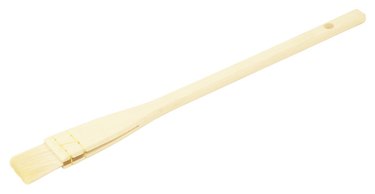Things You'll Need
Canvas drop cloth
Shop rag
1 qt. plaster primer
1-gallon painter's pot
Wooden stirring stick
Polyester craft brushes
Acrylic spray enamel

Plaster figurines come in a variety of shapes and sizes, however, they all have one thing in common, they aren't conducive to uniform paint coverage. Because plaster is very absorbent, it tends to soak up paint. This creates the need for many coats and promotes uneven drying that leads to streaks. To generate a uniform, long-lasting finish on your plaster figurines, apply a special type of primer specifically made for plaster surfaces and condition the primer for better absorption, or you may end up having to apply several coats of paint.
Step 1
Place your plaster figurine on a canvas drop cloth. Clean the figurine with a damp shop rag. Let the plaster dry for at least two hours.
Video of the Day
Step 2
Pour 1 qt. plaster primer into a 1-gallon painter's pot. Add 1 oz. clean tap water. Stir the diluted plaster primer with a wooden stirring stick for three minutes.
Step 3
Apply a single coat of diluted plaster primer to the figurine with a polyester craft brush. Let the plaster figurine dry for two hours.
Step 4
Coat the primed figurine with acrylic spray enamel. Hold the spray enamel 8 inches between the plaster figurine and spray tip when coating the figurine. Let it dry for two hours.
Step 5
Add minor designs or details of your own choosing with a craft brush. Don't handle the finished plaster figurine for two hours.
Tip
You can also use plain acrylic paint on your figurines, however, the finish will not be as durable.
Warning
Don't use plain latex primer on plaster figurines or poor adhesion may lead to a flaky finish.
Video of the Day